
St. Peter's Church in Vienna
| Already 1700 years ago, that is in the 4th century, it is said that a holy house stood here during the reign of the Romans. At that time Christianity was advancing rapidly, that is why one rebuilt an old barrack into a church with a single nave. That could have been the oldest church in Vienna.
A relief on the outside of the wall shows though, that Emperor Charlemagne shall have founded the church in 792. The text beneath says: (Dedicated to) Emperor Charlemagne, the founder of the eastern empire - the sponsor of this church. Interestingly enough you can see the old church from that time to the right, while to the left there is a baroque church, as it looks today, floating in the sky ... This foundation by Charlemagne can very well be just a legend. |
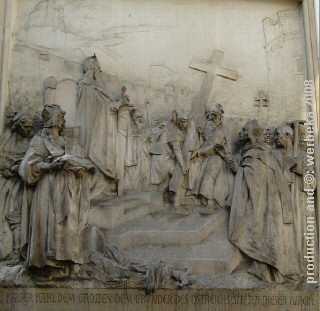 |
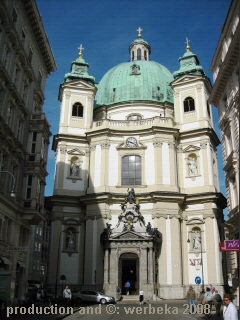 |
The Romanesque church of the early medieval times was later adjusted to Gothic trends. The nave had now got two aisles and there were eight altars. The tower was rectangular and ended on the edges on top into small pointed towers, which were surmounted by a equally pointed roof on the tower.
At the end of the 17th century the church was rather deteriorated and on command of Emperor Leopold I it was torn down in 1701. On this occasion even the adjoining graveyard had to give way to the growing city. Already in the next year Gabriele Montani started to rebuild the church, which afterwards was continued - maybe with changed plans - by Lukas von Hildebrandt and Franz Jänggl. From 1708 it was again possible to hold services here, but the church was completed only in 1733 and sanctified to St. Peter. |
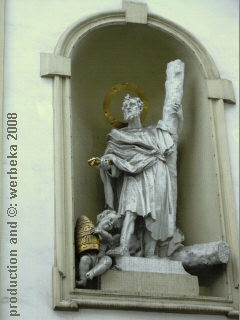 |
When we arrive, we can't go in, as there is a marriage ceremony ongoing. Time enough to walk around the church on the outside. At its backside there is a statue of St. Peter, who, with the key to heaven in his hand, guards the church.
The portal at the front is decorated by the allegorical figures of faith, hope and love. Soon the ceremony is over and a blessedly smiling couple appears out of the entrance. But the photo of them I prefer not to publish here ... |
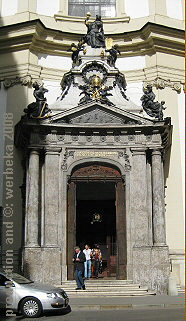 |
Now the inner church is free for making photos - which I really make use of.
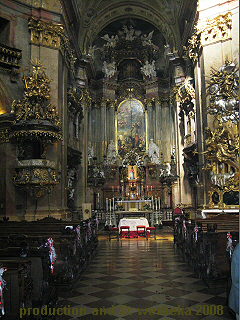 |
The benches are still festooned and in the front at the altar there are the two stools for the bridal couple (oh my God, is this convenient nowadays - at my time I was forced to stand during the whole ceremony). But all those things are rather circumstantial, because the total impression of the church is overwhelming - no matter if you look forward to the main altar or let your eye rest on one of the many details ...
|
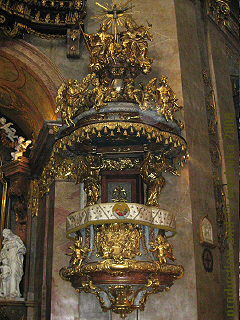 |
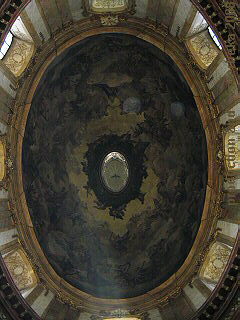 |
A glance upwards to the cupola is also worth the effort. The paintings on the inside of it might appear a little dark, but instead you will be delighted by the intrusion of the light through the lantern, which really almost seems to be supernatural. (A lantern is a top part - with windows - on a cupola.)
Last not least I should mention the side-altars (here on the image is one of six). |
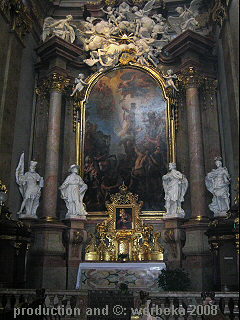 |
Before finishing, two practical advices: Believers can make their confessions here also in foreign languages. It is possible in English, French, Spanish and Italian.
There is a daily concert on the organ - workdays at 3 p.m. and in the weekends at 8 p.m. Furthermore the church has an own choir and an orchestra, both giving about 5 performances a month.
© Bernhard Kauntz, Wolvertem, 2010
Back to  or to the or to the  of of 
16.1.2010 by webmaster@werbeka.com
|

 or to the
or to the  of
of 

 or to the
or to the  of
of 